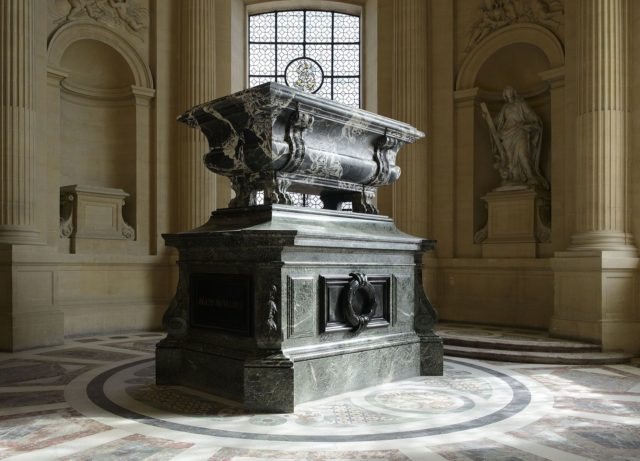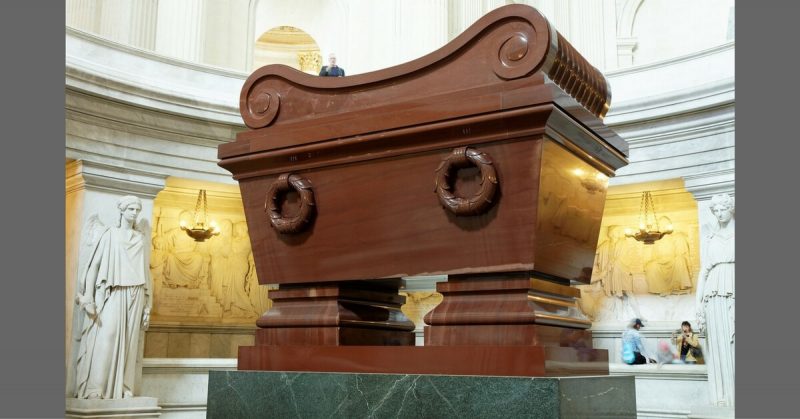To tourists visiting Napoleon’s tomb at Les Invalides in Paris, it seems the most natural thing in the world that he should be buried there. France’s most famous ruler lies buried in state at the heart of his nation.
However, this was not the first place Napoleon was buried. It was only through enormous effort – physical, organizational, and diplomatic – the late Emperor of the French came to be entombed in the nation he loved.
What Napoleon Wanted
Napoleon Bonaparte died in 1821, an exile on the British-owned island of St Helena. His life there, although relatively luxurious compared with most people at the time, was undoubtedly a form of imprisonment. The British, fearful he might return to power and conquest would never let him leave the island.
In his will, Napoleon asked for his ashes to be buried “by the banks of the Seine surrounded by the French people whom I love so dearly.” He had also contemplated burial in Corsica, where he grew up. Above all, he was focused on one thing – that the British would not bury him in London and gain political capital from his death.
St Helena
What Napoleon wanted and what he got were no longer the same thing. Wary of creating a shrine to the Emperor who had challenged their dominance, the British would not allow his remains to return to France.
Instead, Napoleon’s body was interred in a small valley on St Helena, beneath two large flat stones and in the shade of a pair of willow trees. Even the inscription on his tomb was the cause of an argument. The French insisted it simply say “Napoleon” while the British wanted his full name, “Napoleon Bonaparte,” to get away from his imperial imagery.
The July Monarchy
The events that led to Napoleon’s reburial began in 1830. A revolution once again overthrew the French Bourbon monarchy, which had been restored on Napoleon’s fall in 1814 and again after his brief return in 1815.
In place of the Bourbons, the French crowned King Louis-Phillippe, a member of the extended Royal family, but not one in close succession for the crown. His was a more conciliatory rule than the angry, reactionary Bourbons, but it had problems. He was neither the legitimate heir to the throne nor an elected voice of the people. He needed ways to reinforce the legitimacy of his rule.
Affection for Napoleon Bonaparte and his legacy remained high in France. In seeking to return Napoleon’s body, Louis-Phillippe attempted to tie himself to that legacy. He wanted to be seen publicly as the man who had brought back the beloved Emperor. He wanted to remind people of what a monarch made by revolution could achieve.
Diplomacy with Britain
To do this, Louis-Phillippe needed the cooperation of the British. François Guizot, the Ambassador to London and a skilled politician who would later be Prime Minister, was given the task of achieving this. He passed on Louis-Phillippe’s request for the return of Napoleon’s remains as a request from one monarch to another. Pleading humanitarian concerns, he asked that the remains be returned for the sake of those who had served under Napoleon.
It was an excellent idea, but what made the difference was politics. A crisis had arisen in Syria, with Britain and France on opposing sides. Lord Palmerston agreed to the French request in the hope of gaining favor and distracting them from the Syrian issue.

Where to Bury Napoleon?
Lots of planning went into arranging Napoleon’s return to his homeland. It included the decision of where to bury him. Several options were considered, including the Arc de Triomphe and the Basilica of Saint-Denis.
Louis-Phillippe settled on the church at the Hôtel des Invalides. This group of 17th-century buildings was one of the grandest and most prestigious in Paris. Built to care for military veterans it was the perfect symbolic choice, reminding all of France that Napoleon had shared danger and sacrifice with his soldiers, and cared for them when they needed him.
Louis Visconti was commissioned to build a suitable monument at Les Invalides in which to commemorate the Emperor.
Exhumation
With preparations completed, the time had come to retrieve Napoleon’s body. In the autumn of 1840, the Prince of Joinville, Louis-Phillippe’s son, was sent to St Helena with two military ships and 500 men, including two of Napoleon’s former marshals.
Amid solemnity and ceremony, the exhumation began. Digging at night when the air was cooler, the French disinterred Napoleon. Ship’s surgeon Rémi-Julien Guillard oversaw the process and confirmed the body was as expected.
The Journey Home
Napoleon’s remains and the artifacts with which he had been buried were secured in six coffins and caskets. The frigate Belle-Poule carried these vessels for the six-week voyage back to France.
Arriving at Cherbourg, they remained there for a week. More than 100,000 people came to pay honor to their Emperor while he lay there.
A steamer, the Normandie, carried the body from Cherbourg, accompanied by a flotilla of riverboats. Everywhere they went, people lined the Seine to see Napoleon’s remains pass by.
Pomp, Ceremony, and Internment
At last, Napoleon’s remains reached Paris for a grand funeral. Huge crowds lined the routes along which a barge and then a carriage carried his ashes through the city. Imperial eagles and statues of winged Victory flanked the roads. A bronze statue of Napoleon himself watched his return.
At last, at Les Invalides, Joinville handed Napoleon’s ashes with great solemnity to his father, the King. To the sound of Mozart’s Mass for the Dead, Napoleon was laid to rest.
The day was marked with widespread joy and religious solemnity. France’s greatest hero had returned to the nation in death. It was a time to celebrate his greatness and mourn his loss.
Napoleon had come home.
Sources:
Alan Forrest (2011), Napoleon.
